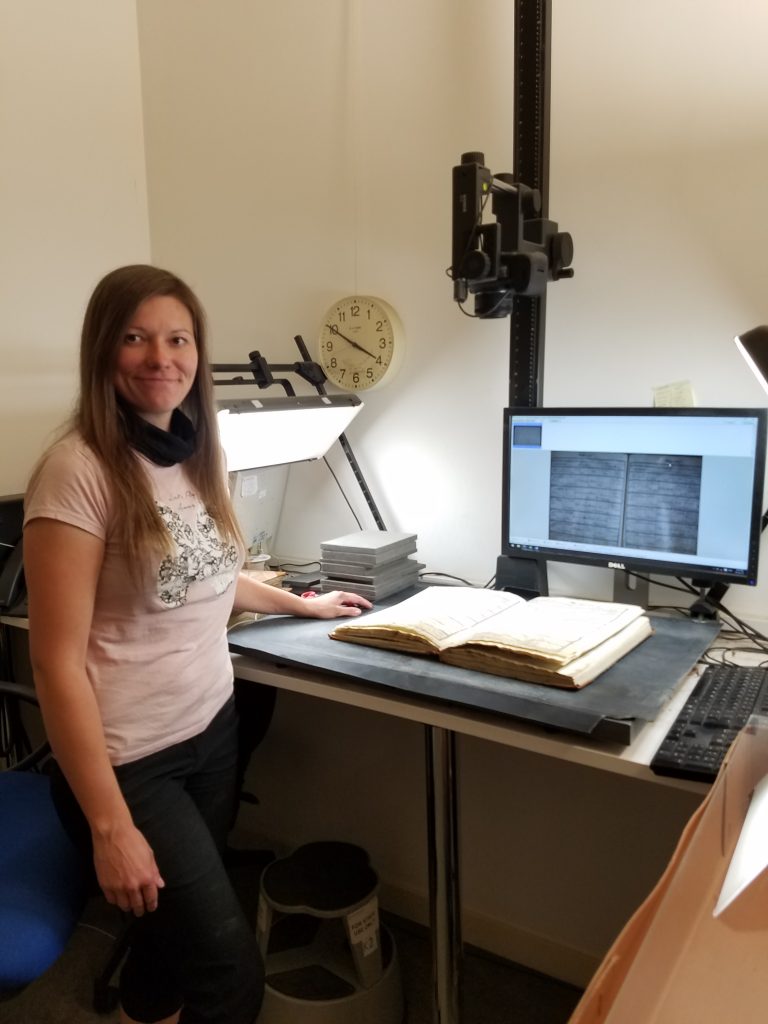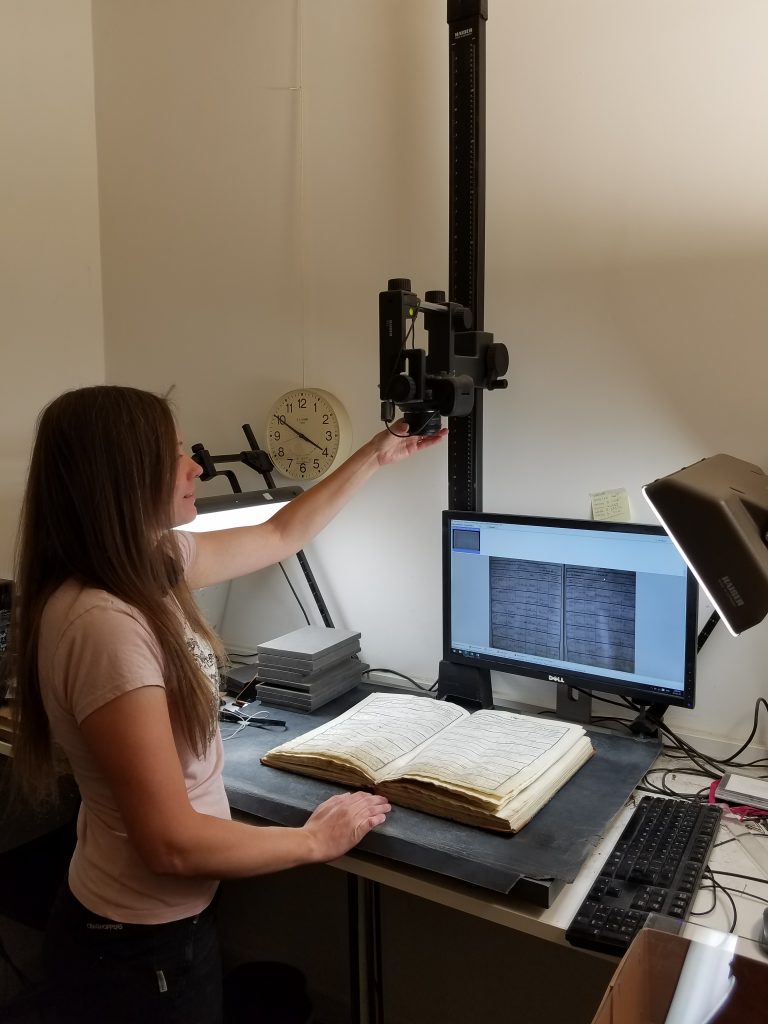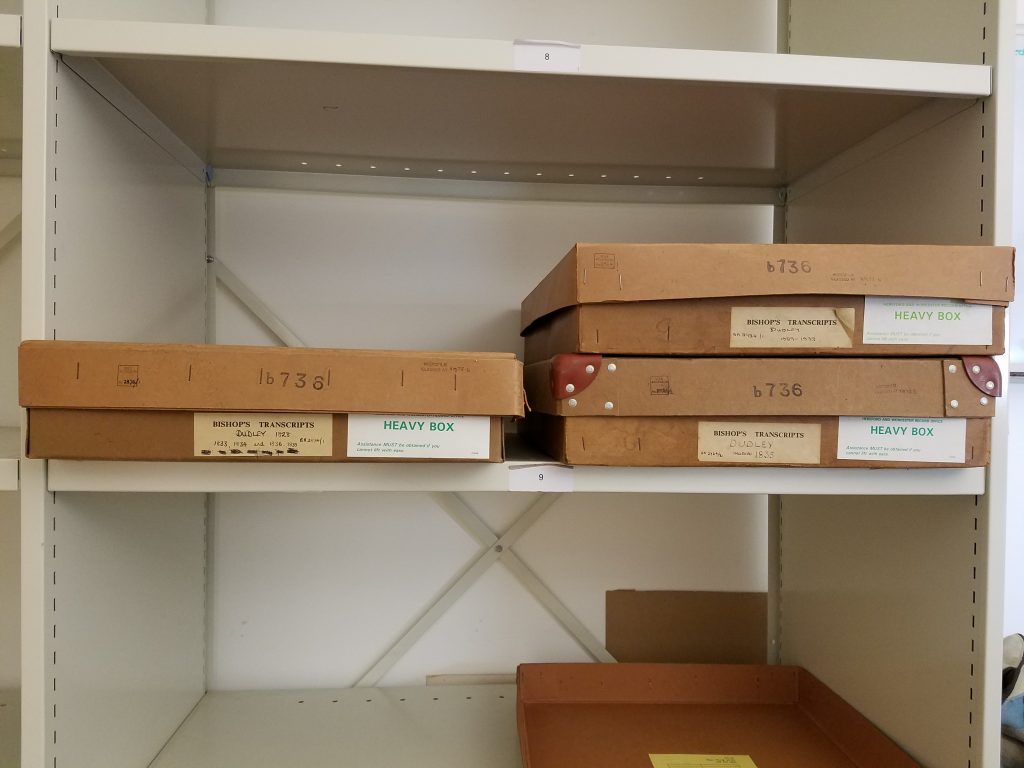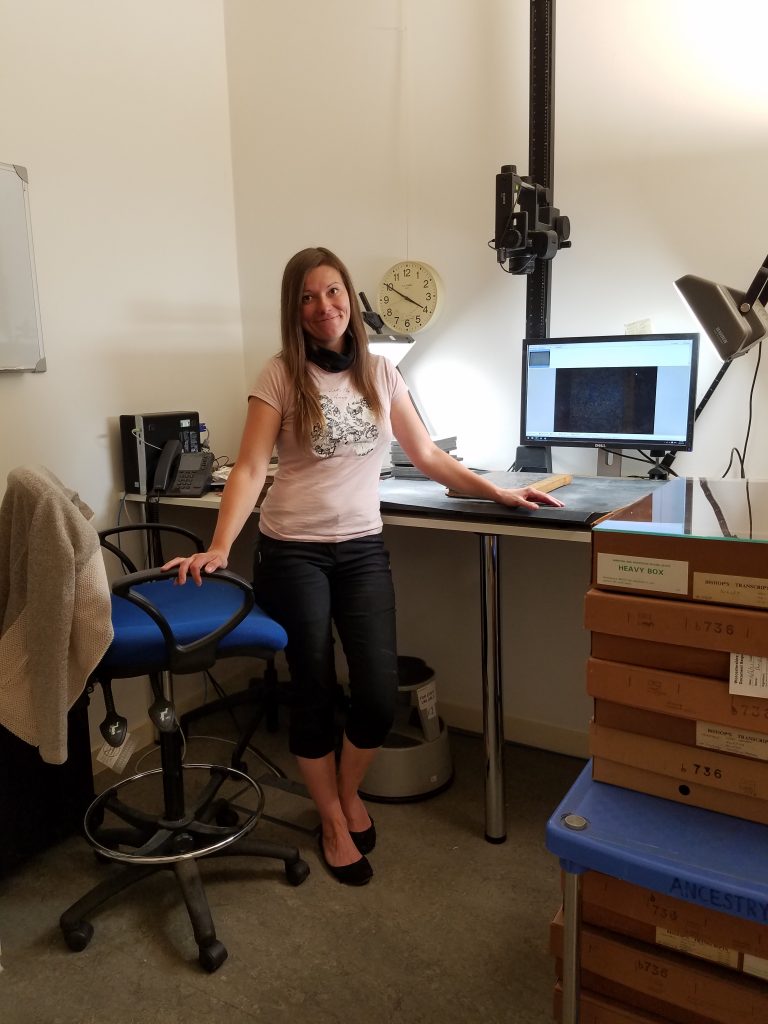Digitising the Bishops Transcripts
- 6th July 2021
At the end of July 2020, I was asked to support the work of our Bishops Transcripts (BTs) photographer who would be joining us temporarily to digitise them, ready to go onto the Ancestry website. Digitising the Bishop’s Transcripts is a huge step forward for records of the Worcester Diocese, making these records available for the first time on the internet, through our partnership with Ancestry.

Agnese digitising the Bishops Transcripts
BTs are not always exact copies of parish register entries and are vital records for genealogists to study in their own right. The BTs are in one collection which makes it logistically easier to carry out the digitisation process as parish registers are spread amongst a wide range of collections. However, plans for digitising parish registers are well advanced.
Upon meeting Agnese I was happy to hear a European twang in her accent. Having a Dutch grandfather myself, who I never really got to know, I asked her where she was from and she replied ‘Latvia’.
Working with Agnese, it’s obvious she has a passion for creativity which appeals to my own background in Fine Art and it’s been lovely hearing about her artistic projects during her time with us. Given Agnese’s Latvian heritage and specialist experience in digitisation of historical records, I thought it would be fantastic to get a few words from her as the digitisation of Bishops Transcripts comes to an end. Hopefully you will enjoy reading about her and it will enlighten you as to the array of professions and skills connected to archives.
*****
Hi Agnese! Tell me about your heritage if you don’t mind?
I was born in Latvia, a small Eastern European country by the Baltic Sea. It is a beautiful place, the land is quite flat, but it more than compensates with beautiful countryside, clean rivers and lots of woodland. Latvia suffered quite significantly during WW1 and WW2 and it has been occupied many times, but despite that, its old traditions and language have survived and the country gained independence again in 1991, when I was just 6 years old. Latvia has Lutheran Catholic and Eastern Orthodoxy religions, but a lot of our traditions come from ancient Latvian pagan life. The biggest celebration of the year is ”Jāņi” the Summer Solstice night, which involves a lot of preparation and tradition – homemade food and beverages, traditional costumes, folk songs, lighting a fire and celebrating until the dawn. Over the course of the year we have many more smaller pagan celebrations, celebrating nature and changes in season. These pagan celebrations are the ones that mean the most to me when I think of my heritage.
Wow, the pagan links sound so interesting! What inspired you/what was your career journey that lead you to move to the UK?
The desire to see the world in me started when I was young. I always wanted to explore and see how other cultures live and somehow I always knew that I would settle somewhere else. I wish it would have been a more romantic story, but my journey started when the 2009 world economic crisis reached Latvia and I decided that it was time for big changes. I chose to come to England because a friend of mine already lived there and I spoke English, or at least I thought I did – I was surprised by all the different English accents and it took a while for my ears to adjust. I do love the accents though, even different regions in Latvia have their own different ways to speak Latvian.

Haha you’ve had time to become familiar with an accent like my own – I have a slight black country twang (black country due to the thick black smog over the area during the industrial revolution). You are settled now in the UK?
Yes I am, very much. English people are generally more smiley, polite and kind than elsewhere. I love the old buildings, structures, houses and gardens and I love the rich history of England – somehow I now feel I have become a part of this land.
Do you miss your family in Latvia , especially whilst Covid has prevented travel?
I do a bit, but I don’t have much of the family left there now. Last time I visited Latvia was in 2016 – I did book a flight in March 2020, which of course I had to cancel due to the first Covid lockdown. I have been visited here by family friends a couple of times, they really enjoyed their cultural visits.
How did you come to be a photographer working with historical records?
I applied for my first role at the Gloucester archives because I like to work in a calm environment and working with old historical documents at the local Historical Archives was a bonus! I often think about all the people in the documents and what their lives were like in the past. That makes me feel honoured to touch with care and digitise these documents from centuries before.
What advice would you give to people wanting to specialise in digitisation or photography of historical documents?
Imaging for me is like a form of meditation, I am imaging thousands of documents every day, so I guess someone wishing to do this job should have patience and attention to detail. Every document is important, it records real life events from the past, so the imaging should be done with great care.

Boxes and more boxes!
How have you found working with the Bishops Transcripts (BTs)? Any challenges?
Every project brings some challenges, but that just makes it more interesting. Bishops Transcripts aren’t always easy to image and the oldest ones are written on old parchments, some of which have suffered from damage in the past such as damp, fire and even rodents. Some of the documents are very large and unusually shaped and that’s when I ask for help from the archive conservation team.
What’s the process for digitisation of BTs? Do you have to do any work to the images after taking the photos? Any equipment you use?
We have a very effective and well organised set up for digitisation. We aim to create a digital surrogate as close to the original as possible, so as to avoid extensive post production work. I use a high resolution DSLR camera and good lights to get the best possible image quality.
What do you enjoy about working with archives more generally?
I love the peaceful and friendly atmosphere, everyone is always very helpful. Even during these difficult times (due to the pandemic) I feel supported, just like everyone else in the Archives.
What’s the funniest, most interesting or memorable archival record you have come across?
I find little old doodles and drawings funny. Once I read the text on an old document saying that the ‘Plague is here’. I have to say I took a great care handling that document! The most memorable project was imaging the old criminal records at the West Midlands Police Museum. It was sad to see the harsh punishments for what we call minor crimes these days; such different times.

What other digitisation projects have you been a part of?
I’ve been a part of many different projects like parish registers, Bishops Transcripts, electoral registers and criminal records. I have been lucky enough to work on projects at Gloucester Archives, the West Midlands Police Museum, the National Archives and even the Deutsche Nationalbibliothek in Germany.
So many projects! Tell us about your other creative work e.g your sculptures?
Well, I have some unusual hobbies which include restoring old violins, my own classic car and stitching steering wheels for old classic cars! You can see where my love for old things originates. About three years ago I discovered and fell in love with a new hobby – needle felting art – and I learned how to make realistic sculptures of animals in wool. I absolutely love wildlife and animals and replicating them this way is very satisfying and I learn a lot more about them.
What archival projects are you moving on to next?
I will find out about my next project in upcoming weeks – but I am sure it is going to be just as interesting as those I have worked on in the past.
When will the BTs be available online?
I can’t say for sure as I’m in process of finishing the project and there is a process for all the images to go through, but when they are available I am sure people will get just as much enjoyment from researching them as i did imaging them.
Thanks Agnese!
Thank you
*****
Hopefully this has inspired lots you to use the archives or to or work with them in more ways you had imagined. It has been wonderful having Agnese with us and she has provided so much insight in this interview. Watch this space for news about the BTs going online and our next projects to digitise our draft guides and parish registers!
Post a Comment